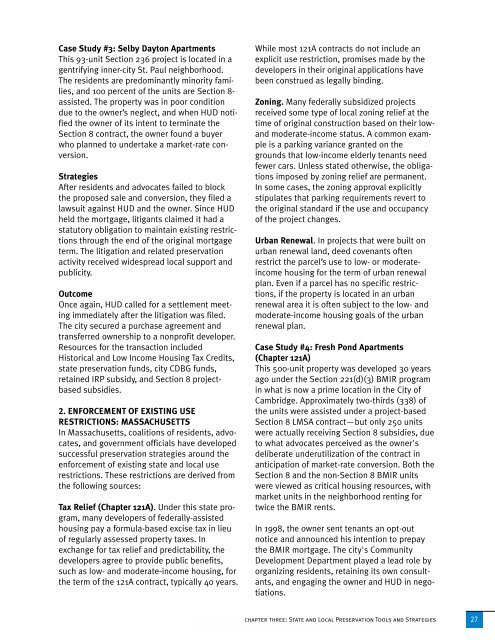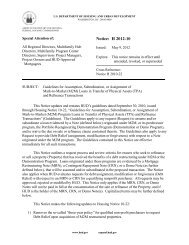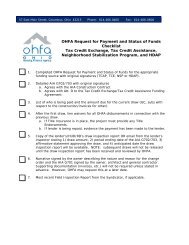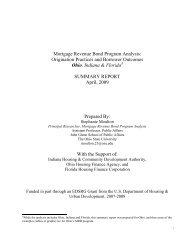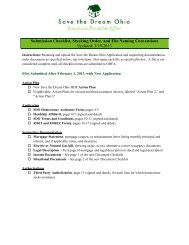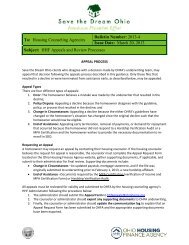lis 217 stemming the tide - LISC
lis 217 stemming the tide - LISC
lis 217 stemming the tide - LISC
- No tags were found...
Create successful ePaper yourself
Turn your PDF publications into a flip-book with our unique Google optimized e-Paper software.
Case Study #3: Selby Dayton ApartmentsThis 93-unit Section 236 project is located in agentrifying inner-city St. Paul neighborhood.The residents are predominantly minority families,and 100 percent of <strong>the</strong> units are Section 8-assisted. The property was in poor conditiondue to <strong>the</strong> owner’s neglect, and when HUD notified<strong>the</strong> owner of its intent to terminate <strong>the</strong>Section 8 contract, <strong>the</strong> owner found a buyerwho planned to undertake a market-rate conversion.StrategiesAfter residents and advocates failed to block<strong>the</strong> proposed sale and conversion, <strong>the</strong>y filed alawsuit against HUD and <strong>the</strong> owner. Since HUDheld <strong>the</strong> mortgage, litigants claimed it had astatutory obligation to maintain existing restrictionsthrough <strong>the</strong> end of <strong>the</strong> original mortgageterm. The litigation and related preservationactivity received widespread local support andpublicity.OutcomeOnce again, HUD called for a settlement meetingimmediately after <strong>the</strong> litigation was filed.The city secured a purchase agreement andtransferred ownership to a nonprofit developer.Resources for <strong>the</strong> transaction includedHistorical and Low Income Housing Tax Credits,state preservation funds, city CDBG funds,retained IRP subsidy, and Section 8 projectbasedsubsidies.2. ENFORCEMENT OF EXISTING USERESTRICTIONS: MASSACHUSETTSIn Massachusetts, coalitions of residents, advocates,and government officials have developedsuccessful preservation strategies around <strong>the</strong>enforcement of existing state and local userestrictions. These restrictions are derived from<strong>the</strong> following sources:Tax Relief (Chapter 121A). Under this state program,many developers of federally-assistedhousing pay a formula-based excise tax in lieuof regularly assessed property taxes. Inexchange for tax relief and predictability, <strong>the</strong>developers agree to provide public benefits,such as low- and moderate-income housing, for<strong>the</strong> term of <strong>the</strong> 121A contract, typically 40 years.While most 121A contracts do not include anexplicit use restriction, promises made by <strong>the</strong>developers in <strong>the</strong>ir original applications havebeen construed as legally binding.Zoning. Many federally subsidized projectsreceived some type of local zoning relief at <strong>the</strong>time of original construction based on <strong>the</strong>ir lowandmoderate-income status. A common exampleis a parking variance granted on <strong>the</strong>grounds that low-income elderly tenants needfewer cars. Unless stated o<strong>the</strong>rwise, <strong>the</strong> obligationsimposed by zoning relief are permanent.In some cases, <strong>the</strong> zoning approval explicitlystipulates that parking requirements revert to<strong>the</strong> original standard if <strong>the</strong> use and occupancyof <strong>the</strong> project changes.Urban Renewal. In projects that were built onurban renewal land, deed covenants oftenrestrict <strong>the</strong> parcel’s use to low- or moderateincomehousing for <strong>the</strong> term of urban renewalplan. Even if a parcel has no specific restrictions,if <strong>the</strong> property is located in an urbanrenewal area it is often subject to <strong>the</strong> low- andmoderate-income housing goals of <strong>the</strong> urbanrenewal plan.Case Study #4: Fresh Pond Apartments(Chapter 121A)This 500-unit property was developed 30 yearsago under <strong>the</strong> Section 221(d)(3) BMIR programin what is now a prime location in <strong>the</strong> City ofCambridge. Approximately two-thirds (338) of<strong>the</strong> units were assisted under a project-basedSection 8 LMSA contract—but only 250 unitswere actually receiving Section 8 subsidies, dueto what advocates perceived as <strong>the</strong> owner'sdeliberate underutilization of <strong>the</strong> contract inanticipation of market-rate conversion. Both <strong>the</strong>Section 8 and <strong>the</strong> non-Section 8 BMIR unitswere viewed as critical housing resources, withmarket units in <strong>the</strong> neighborhood renting fortwice <strong>the</strong> BMIR rents.In 1998, <strong>the</strong> owner sent tenants an opt-outnotice and announced his intention to prepay<strong>the</strong> BMIR mortgage. The city's CommunityDevelopment Department played a lead role byorganizing residents, retaining its own consultants,and engaging <strong>the</strong> owner and HUD in negotiations.chapter three: State and Local Preservation Tools and Strategies 27


